DFI X48 LT T2R: Floats like a Butterfly…
by Rajinder Gill on April 28, 2008 4:00 AM EST- Posted in
- Motherboards
Board Layout and Features
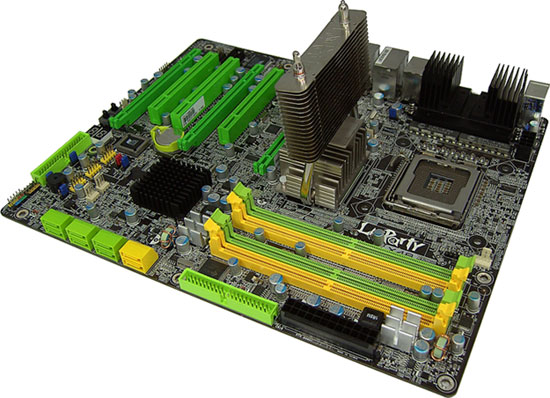 |
As with other LANParty boards, DFI's near-flawless layout continues. Cooling on the LT version is probably the best overall solution rather than opting for the upcoming UT version of this board, which connects all three heatsinks with a heatpipe. Having independent heatsinks allows users to replace a single section with more exotic cooling should they so desire, although we found that the stock Northbridge cooler (supplied by Thermalright) is very good. Teamed up with suitable airflow the Thermalright NB cooler is capable of dissipating large amounts of heat. Although we still recommend that active cooling is used on both the Northbridge and PWM area when overclocking this board.
Large CPU coolers like the Thermalright Ultra-120 must be mounted in horizontal orientation to provide clearance for the stock Northbridge cooler. This is not really a bad thing - using two 120mm fans in push-pull on the Thermalright 120 cooler will also cool the Northbridge heatsink very effectively. Using this combination of coolers with two 120mm fans in push-pull kept our full-load Northbridge temperatures under 42C even while using around 1.6VMCH.
We must stress that cooling the PWM heatsink is a little tricky when the board is mounted in a case. We used a small fan in combination with a couple of small machine screws to attach the fan to the PWM heatsink. We recommend that users monitor PWM load temperatures via the supplied ITE monitoring software and try to ensure that PWM temperatures remain around 50C under full load.
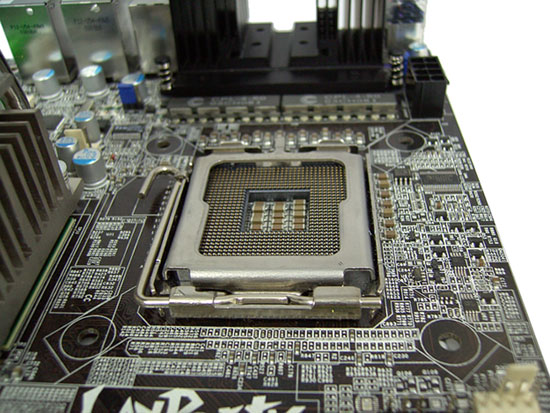 |
All of DFI's performance oriented motherboards over the past year have featured 8-phase Volterra digital PWM circuitry to supply CPU power, and there's no change here. However, we would like to see the inclusion of a heatsink backplate on future DFI boards to ensure that the small Volterra MOSFETs do not lose contact with the heatsink when the motherboard bows under pressure from some of the higher torque mounting systems used on CPU coolers. As the Volterra MOSFETs are so small, any loss of contact between the FET and heatsink during a heavy transient load will result either in board shutdown or something catastrophic.
Even though we did not experience these problems ourselves, we feel the current implementation certainly has room for improvement. The EPS 12V power connector sits just behind the PS/2 ports at the top corner of the board, while the CPU fan header is situated adjacent to the first DIMM slot. There are six fan headers on the board - three of which are OS controllable via the supplied ITE monitoring software.
 |
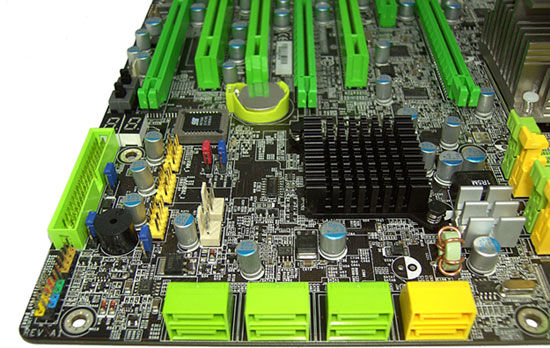 |
The overclocking friendly layout continues to an easily accessible CMOS battery, and onboard power and reset switches featuring EZ CMOS clear and of course the LED POST Code display. The floppy drive connector sits at the lower edge of the board to the right of the POST Code display. The six Intel ICH9R SATA ports are located at the lower right edge of the board, facing to the right making connector insertion a tad awkward at once the board is mounted in a case. There are also two JMicron JMB363 SATA ports situated above the Intel SATA ports.
The memory slot connectors are situated almost in line with the primary PCI Express connector; large graphics cards such as the 8800 GTX may have to be removed when swapping out memory modules. The 24-pin ATX connector is placed to the right of the slots and does not hinder the use of the IDE connector below it.
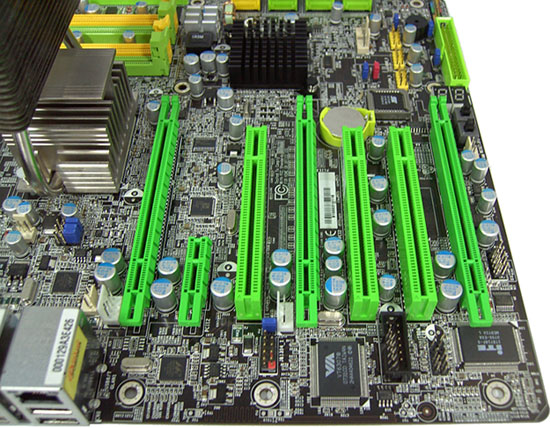 |
The expansion slot layout is comprised of three PCI Express x16 full length slots (two x16 bandwidth and one x4 bandwidth slot), one PCIEx1 slot, and three PCI slots. The supplied Bernstein Audio module features the Realtek ALC885 8-channel High Definition Audio CODEC and has its dedicated connector placed between the PCI slots, rendering one of the PCI slots inactive if the module is used. There are three onboard USB connectors for an additional six USB ports, a connector for an external COM port, one IrDA connector, one CIR connector, and a connector for the second IEEE-1394 port.
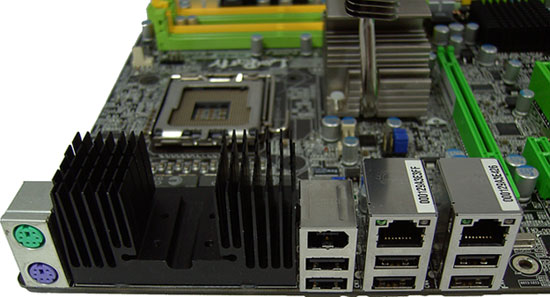 |
The rear I/O options include six USB ports, an IEEE-1394a port, two Gigabit LAN ports with teaming options, and finally the standard PS/2 keyboard and mouse ports.










24 Comments
View All Comments
Ephebus - Tuesday, April 29, 2008 - link
I remember a time when I was considering the purchase of a midrange ASUS motherboard with a reasonable set of overclocking options in the BIOS but no PCI-E clock setting, and there was no information on the specifications page or the manual as to how that setting would behave when overclocking. I then wrote to ASUS asking if the PCI-E clock was always locked by the board at 100 or if it would vary according to the CPU clock setting, and was actually told by an ASUS support "technician" to "go read a book on overclocking". I managed to get the info later on a forum from a person who owned the board and was kind enough to check it out for me. And that is, when ASUS support doesn't simply delete your support inquiry.With DFI I've managed to actually have short conversations with the technical support staff in the past, was able to report minor BIOS bugs and see them fixed on the next release, etc., so at least for me it's not just a question of whether a DFI motherboard can reach a few MHz more than an ASUS competitor or not on this or that benchmark, it's also all about the feeling of satisfaction from owning a product made by a company that has this kind of attitude towards users, and that always does their best to meet the needs and wishes of enhusiasts. I'll gladly pay more for a DFI product anytime.
Intelman07 - Monday, April 28, 2008 - link
Is there a reason Anandtech reconmends ~400FSB for quad core, does a lower multiplier and a higher FSB increase performance more in a quad core chip?Rajinder Gill - Monday, April 28, 2008 - link
Hi Intelman07,This applies in relation to the FSB limits of the quad cores only ON THIS board; 400 FSB at a trd running near 5-6 will give you a read delay time of around 13ns. Anything over 420 FSB needs a hike in trd while 440+ you need to be looking twoards a trd of 8 which is a delay of 17ns. The drop in write/copy speed bandwidth by reverting to 400FSB is only 500mbs while reads gain 500mbs running the lower tRD (swings and roundabouts). Now factor the VTT and VMCH requiremnts of the higher FSB and it becomes to click.
For more insight into this, 2 of our articles here will explain the fundammnetals and reasoning a little better.
http://www.anandtech.com/mb/showdoc.aspx?i=3208&am...">http://www.anandtech.com/mb/showdoc.aspx?i=3208&am...
and also logical approach to system tuning using Kris' excellent groundwork.
http://www.anandtech.com/cpuchipsets/showdoc.aspx?...">http://www.anandtech.com/cpuchipsets/showdoc.aspx?...
Other boards which vcan hit higher FSB's and low tRDs change these rules a little. But for the most part, the truth is that FSB overcloking on the quads and Joe Public - 400FSB really is realistic and attainable with real stability - and this is important to a majority of our readers. Of course, we still use our cascades from time to time and hammer the boards real hard without any of the logic written here applied.
The interetsing part comes as no surprise - yup - this all favors unlocked multiplier processors aka QX9650 and 9770 class, just up the FSB - keep the tRD low and hey presto!
The beauty of this board is that it gets close to that tRD 12.5ns latency time at 400FSB at 1.25VMCH and 8GB of memory with no need for GTL tuning- easy as pie- with performance that you can't swing anywhere else using a 12mb cache quad on this board.
Hope that clears it up a little..
regards
Raja
Bozo Galora - Monday, April 28, 2008 - link
Another great article by AT's best reviewer.I have read somewhere DFI's top X48 board gonna have ICH10R and cost ~$400??
Slash3 - Monday, April 28, 2008 - link
Page 2 states "The expansion slot layout is comprised of three PCI Express x16 slots (two x16 and one x4 slot), and three PCI slots."The board itself has 3 physical PCI-E 16x slots and 1 PCI-E 4x slot though, so the sentence is kind of ambiguous.
takumsawsherman - Monday, April 28, 2008 - link
It's the wicked fast 400Mbps version, rather than 800Mbps. Wouldn't want to advance the field. Nope, let's use the 10 year old ancient variety, rather than the 5 year old less ancient variety.I've got an even better idea... Why not throw in some USB 1.1 ports.
Rob94hawk - Monday, April 28, 2008 - link
I got all excited and then I saw DDR2....Might as well just replace PCIE with AGP while their at it.
Rajinder Gill - Monday, April 28, 2008 - link
Just contacted DFI, they are aiming at retail launch of the DDR3 version on the 20th May..Review sample boards should ship within the next week..
regards
Raja
Rajinder Gill - Monday, April 28, 2008 - link
EDIT: Make that early June for full retail (allowing for shipping time etc)..regards
Raja
Rob94hawk - Wednesday, April 30, 2008 - link
Will be looking forward to it. Thank you.